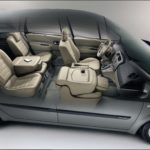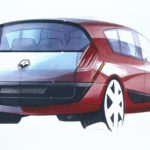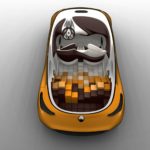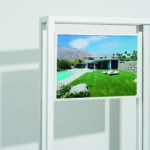Archives for :
History
Running from May 3 to September 18, the Audi ‘museum mobile’ is presenting 12 coupés from the 1930s to the present day, in an exhibition titled “Dynamic Sculpture – the Tradition of Sportiness and Elegance at Audi.â€
- Highlight: A replica of the “Manuelaâ€, a Horch 853 Coupé. In 1937, Auto Union had this luxury car made for Bernd Rosemeyer, its most famous racing car driver.
- The first Audi Coupé of the post-war era: The Audi 100 Coupé S had its market launch in 1970.
- Coupés seemed to have been created solely for long-distance races – like the DKW Monza from 1956 at the Mille Miglia in Italy.
When vehicles with the coupé body type first appeared on the scene, they were often known as “Les Désobligeantes†(the unobliging ones). The style takes its name from the idea to “cut†(“couper/coupé†in French) a four-seater coach body to create a two-seater. The result was a body type that aroused the interest of the elite set. And in the years that followed, the high-quality interior equipment and trim installed in coupes made them the favorite vehicles among the high society of major European cities.
With the initial attempts at streamlined design in the 1930s, the roof form sloping downward to the rear began to catch on. The criteria by which we define a coupé today emerged only gradually, however: a short, flattened roof resting on two posts, with a two-seat interior. The coupes really hit their stride in the 1950s and 1960s. A key factor behind this popularity was the long-distance races of the period, like the Mille Miglia, the Targa Florio, the Liège-Rome-Liège race and the “2000 km durch Deutschland†(2,000 kilometers though Germany), which almost seemed to have been conceived specifically for coupes. Typical of coupe design was the combination of a great looking exterior and the best technology. Still today, the coupe is seen as the jewel in the product lineup of every automaker.
At the show will be 12 coupés from Audi history. A particular highlight is a replica of the “Manuela,†a unique coupé version of the Horch 853. The car was specially built for Bernd Rosemeyer in 1937. The most successful and most popular Grand Prix driver for Auto Union back then, Rosemeyer loved this luxury automobile – a passion clearly captured in countless photographs. This and the fact that the motorsport star was killed while attempting a world record run just a few months after he got the car, exalted the Horch “Manuela†to its legendary status. It is believed the original coupe disappeared without a trace during World War II.
Other treasures from the annals of company history trace the body type through the 1950s: a rare DKW Meisterklasse Coupé with a body by the specialist company Hebmüller, a DKW Monza (1956), the Auto Union 1000 Sp (1958) and an NSU Sport Prinz (1959). Also included in the exhibition is the first Audi coupe of the post-war era, the Audi 100 Coupé S from 1970. Representing the historic return of the four rings to the premium segment are the Audi Coupé GT (1980), the Audi quattro (1981), the Audi Sport quattro (1983) and the Audi Coupé from 1988. Visitors will also have the opportunity to see the first edition of the style icon Audi TT from its debut year 1998. And finally, the path to the present culminates with the Audi A5 from 2007.
Mercedes-Benz will be attending the Retro Classics in Stuttgart, offering visitors a journey through time in the fascinating world of the brand’s cabriolets and roadsters. The exhibition covers everything from the 300 SL racing sports car (W 194) from 1952 and the classic sports car 300 SL Roadster (W 198) from 1957, the 190 E 2.6 Cabriolet prototype (W 201) from 1990, to the new SL (R 231) and the recently premiered C-Class Cabriolet (A 205).The 300 SL racing sports car (W 194) and the 300 SL Roadster (W 198) bear testimony to the successes of the 1950s and the SL legend. The racing sports car stands for the overwhelmingly successful return of Mercedes-Benz to motor racing in the 1952 season for the first time after the Second World War. The vehicle proved an outright winner, securing impressive double victories at the 24 Hours of Le Mans and the Carrera Panamericana in Mexico. The racing sports car also gave rise to the famous standard-production “Gullwing†300 SL (W 198) from 1954, which made its debut in spring 1957 in the open-top variant, the 300 SL Roadster. Together with the 190 SL (W 121) launched in 1955, the 300 SL Roadster started the tradition of open-top Mercedes-Benz standard-production sports cars with the magical abbreviation SL, which the new generation of the SL (R 231) propels forward into the future.
A glance back at 1990 reveals how the Mercedes-Benz development department was toying with the idea of producing a cabriolet to join the compact saloon (W 201). The original prototype on display at the Retro Classics is the road-going result of these deliberations. Even if the open-top “Baby Benz†did not enter series production, the study was a key decision-making aid for the 124 series Cabriolet unveiled in 1991 and today ranks among the forebears of the new C-Class Cabriolet (A 205).
For those looking to buy..
The ‘All Time Stars‘ from Mercedes-Benz Classic have their own stand in Hall 7 at the Retro Classics. The line-up features all cars made by Mercedes-Benz and the predecessor brands. The focus is on classics that are suitable for everyday driving. Maximum transparency was the guiding principle behind their selection: the Mercedes-Benz Classic experts subjected each vehicle to a comprehensive 160-item checklist.
Cars exhibited by Mercedes-Benz Classic at theRetro Classics 2016
Nürburgring, 3rd August 1952. Fritz Rieß in car 22, the Mercedes-Benz Type 300 SL Roadster (W 194, 1952) in 3rd place.
300 SL was the designation of the competition racing car from Mercedes-Benz with which the brand returned to international motor racing in 1952 for the first time after the Second World War. Following the triumphant double victory in Le Mans and the previous double victory at the Bern Grand Prix, the 300 SL also won the two other races where it had lined up on the grid. The 300 SL took the top four places at the Nürburgring Great Jubilee Prize in the weight-reduced roadster version, while the Carrera Panamericana, a gruelling endurance race covering more than 3100 kilometres through Mexico, saw the car finish with a double victory. Karl Kling and Hans Klenk took first place in Mexico despite colliding with a vulture that smashed through the windscreen during the race. Even if the successful racing sports car was not sold to the public, it did light the fuse for the development of the subsequent Mercedes-Benz SL, which was launched at the end of 1953.
Produced: 1952
Cylinders: 6/in-line
Displacement: 2996 cc
Output: 125 kW (170 hp)
Top speed: 230 km/h
Mercedes-Benz Typ 300 SL Roadster (W 198 II, 1957 bis 1963), 1960. Posing does not get better than this.
Mercedes-Benz 300 SL Roadster (W 198, 1957-1963)
Mercedes-Benz unveiled the 300 SL Roadster as the successor to the 300 SL Gullwing Coupé at the Geneva Motor Show in March 1957. On a technical level, the open-top sports car was very like the Coupé, although the modified space frame allowed the installation of conventionally attached doors, which were necessary for open-top driving. The suspension was likewise modified: the single-joint swing axle with lowered pivot point on the 300 SL Roadster was equipped with a compensating spring for the first time. From 1958 onwards, the Roadster was also available with a detachable coupé roof. It was from the standard-production 300 SL Roadster that the Mercedes-Benz engineers developed the 300 SLS racing variant with which Paul O’Shea won Category D of the American Sports Car Championship in 1957. Production of the 300 SL Roadster was discontinued after seven years in 1963, during which time precisely 1858 examples of the highly exclusive sports car were built.
Produced: 1957-1963
Cylinders: 6/in-line
Displacement: 2996 cc
Output: 158 kW (215 hp)
Top speed: up to 250 km/h
Mercedes-Benz 190 E 2.6 Cabriolet prototype (W 201, 1990)
Following the facelift of the Mercedes-Benz W 201 series, which was unveiled in 1988, the brand turned its attention to a cabriolet. The result was a road-going prototype, which stood out with its four fully-fledged seats and enhanced body with subtly higher, slightly more angular rear where the large folding top was concealed under a metallic lid. The two-door cabriolet also boasted an elegant side line even with the roof closed. The car ultimately failed to make it into series production, yet the study served as a decision-making aid on the way to the larger 124 series Cabriolet, which was launched in 1992 and was among the forebears of the current E-Class Cabriolet. The compact cabriolet prototype features a 2.6-litre six-cylinder engine in tune with the sporty, exclusive aspirations of the open-top two-seater. This powerplant has been available in the 201 series since 1985, propelling the most powerful model in the compact class after the “V16 engineâ€.
Produced: 1990
Cylinders: 6/in-line
Displacement: 2597 ccO
utput: 122 kW (166 hp) at 5800 rpm
Mercedes-Benz C-Class Cabriolet (A 205, since 2016)
The new C-Class Cabriolet premiered at the 86th Geneva International Motor Show in early March 2016. It is the first standard-production cabriolet in the history of the Mercedes-Benz C-Class, which started with the W 201 (“190â€) in 1982. The Cabriolet is closely related to the C-Class Coupé (C 205) whose silhouette it adopts along with the striking front end featuring a diamond radiator grille, LED High Performance headlamps, long bonnet and high beltline. The soft top with glass window transitions harmoniously into the distinctly styled rear end with its highly sporty look. With a capacity of 360 litres (285 litres with the roof open), the boot is capable of holding an exceptional amount of luggage for a cabriolet, thus offering high everyday practicality. Inside, the C-Class Cabriolet with its high-quality materials provides a fresh, sporty reinterpretation of the interior of the C-Class Saloon. Added to which are extensive assistance systems tailored to safety and comfort – through to solutions for semi-autonomous driving. The automatic AIRCAP draught-stop and the AIRSCARF neck-level heating are available as options. Altogether eight different engines are available for the market launch in July 2016, including two diesel models and the C 43 4MATIC Cabriolet as the top-of-the-line model.
Cylinders: 4/in-line to V6
Displacement: 1595 to 2996 cc
Output: 115 kW (156 hp) to 270 kW (367 hp)
Top speed: 250 km/h (governed)
Combined CO2 emissions: from 116 g/km
Mercedes-Benz SL Roadster (R 231, since 2016)
The R 231 series SL with its advanced technology and new styling was premiered at the Los Angeles Auto Show in November 2015. The facelifted Roadster is due to be launched in April 2016. It marks the continuation of Mercedes-Benz’s unique tradition of elegant sportiness, which began with the motorsport-inspired 300 SL in the 1950s. Compared with the first version of the R 231 unveiled in 2012, the new SL boasts an even more dynamic design and more powerful engines. Furthermore, the 9G-TRONIC automatic transmission, DYNAMIC SELECT with five transmission modes and Active Body Control with curve tilting function elevate the Roadster’s ride comfort and sportiness to new levels. The roof, which can now be operated at speeds of up to 40 km/h, and the automatic boot separator are further convenience features which make the luxury sports car even more of a pleasure to drive.
Cylinders: V6 (SL 400) to V12 (SL 65)
Displacement: 2996 to 5980 cc
Output: 270 kW (367 hp) to 463 kW (630 hp)
Top speed: 250 km/h (governed)
Combined CO2 emissions: from 175 g/km
The Renault Scénic, which was the European car industry’s first compact MPV, is celebrating its 20th anniversary in 2016. We take a quick look at some of the concepts and design iterations of the Scénic.
“The world would be a sad place for me, without great design†–
Gerry McGovern.
Modern automotive design is, by necessity, high-tech and computer-led – leading to the belief that the human touch has largely been lost. But it is no coincidence that the imaginative mind behind one of the most successful car marques in existence takes influence from beyond the computer screen in order to design cars that provoke thought, interest, emotion and affection.
The Range Rover is just such a car. Launched in its original guise in 1970, it truly deserves to be called a ‘design icon’ – a status it has achieved through four model generations, the latest of which has even been hailed as ‘possibly the best car ever made’.
And now, as Range Rover celebrates its 45th anniversary, Land Rover’s Design Director and Chief Creative Officer Gerry McGovern gives an insight into five objects that have inspired and influenced the way in which he approaches his work.
1. Round Café, Coventry
This cylindrical café, which opened in the late 1950s, was a symbol of the modernist design philosophy introduced by Coventry town planner Donald Gibson, and has been regarded as a city centre landmark ever since.
The building, like many built in Coventry at the time, stood as a symbol of post-war optimism. Gerry says: “During the 1960s, the whole city centre was really modern, with mosaic tiling and large expanses of glass – most of the buildings in the town centre were forward thinking.
“My mother worked in the café for a while and I used to sit in there as a child. It felt like being in a spaceship. So I was introduced to this world of modernism and futuring from a very young age, which is something that has always stayed with me.â€
2. Eames lounge chair
The iconic Eames Lounge Chair was designed by Charles and Ray Eames for the Herman Miller furniture company in 1956. The chair’s unique shape, exposed structure and base materials of molded plywood and leather is said to be inspired by a baseball mitt.
The Eames chair has been a design favourite of Gerry’s for many years, representing a timeless piece that has both utility and purpose at its core. Gerry says: “It is perhaps an obvious choice for a designer to make, however it’s so good and continues to give me pleasure, which is what ultimately all good design should have the ability to do. For me, it’s a piece of design that is still relevant today.
“The Eames chair has certain values that are important to me as a designer. For example, being true to materials. The fact that, rather than covering up the structure, the designers chose to celebrate it. However, by continually refining and updating the materials and finishes, as well as improving the quality of construction with more contemporary materials, softer leathers and lighter woods, means that it’s still as relevant today as the day it was designed.â€
3. Josef Albers – ‘Never Before I’ series
German-born Josef Albers was an artist and teacher who specialised in painting, printmaking, murals and architecture. After emigrating to America in the 1930s, Albers was regarded as an important influence on generations of younger artists and was credited as an innovator in the fields of Op art and Colour Field painting.
The clarity and precision of Alber’s work is of particular significance to Gerry, he says: “Albers is recognised as one of the world’s greatest modernist printmakers. To me, the beauty lies in the precision of each colour against the other. There is absolute clarity in his work.
“One of the reasons why I admire Albers so much is the precision that he achieved through silkscreen printing, which meant he could create perfect lines of connecting colour. The colours are so vibrant, so rich. I never tire of his work – I bought my first collection by Albers more than 15 years ago and while I’ve sold many other artists work over the years, I’ve always kept the Albers.
“When creating an initial vehicle design, you start with the fundamentals, which are optimized volume and proportions and followed on by surfacing and detail. There is a sense of graphic design and symbolism in a lot of my favourite art, Albers’ printmaking is a perfect example.â€
4. Kaufmann Desert House, Palm Springs, California
Designed by Richard Neutra in 1946, the Kaufmann House is located in Palm Springs, California. It was created for the businessman and philanthropist Edgar Kaufmann and was purposefully designed to sit in juxtaposition with the surrounding mountains. It is seen as a prime example of modernist architecture.
The design aesthetic particularly resonated with Gerry, he says: “The Kaufmann House has that sense of bringing the outside in, which is something that we deliberately tried to incorporate with the inclusion of the panoramic roof on our Range Rovers.
“Many of our customers are being chauffeured through cities and want to look up and be able to take in their surroundings. We felt that it was important to introduce the large glass roof so we could bring a sense of the environment into the vehicle and thus create a sense of occasion.â€
5. Patek Philippe Calatrava watch
Since 1851, Patek Philippe has produced some of the world’s greatest timepieces and its unpretentious, yet sophisticated designs have been a mainstay throughout its history. Gerry owns two examples of the Swiss ultra-luxury watch manufacturer’s work – the Nautilus and Calatrava. He says: “The Calatrava particularly represents, in my view, a masterclass in simplicity and sophistication. It’s as much about what it doesn’t say, as what it does say. It’s a beautiful thing – the notion of ‘less is more’ is a fundamental part of its design philosophy. Every detail on the watch is doing a job.â€
Gerry concludes: “All five of these objects have the ability to connect on an emotional level. For me, emotional design has three key components. The first is visceral – when you look at it do you desire it. The second is behavioral – when you use it does it do what it’s meant to do. And finally, reflective – once you have experienced it, does it continue to excite. To me, Range Rover epitomizes all three of these components.â€
Gerry McGovern is Design Director and Chief Creative Officer for Land Rover. After completing a degree in industrial design at Coventry University, McGovern studied for a Masters at the Royal College of Art in London, specialising in automotive design. His early career took in stints at Chrysler, Peugeot and Rover Group, where he was lead designer of the critically acclaimed MGF sports car, Land Rover Freelander and third generation Range Rover.
After a spell at Ford Motor Company heading up Lincoln-Mercury, McGovern returned to the UK to run a design consultancy in London before rejoining Land Rover in 2004 as Director, Advanced Design. He was appointed Land Rover Design Director in 2006 and his position has since grown to include the role of Chief Creative Officer and he is an Executive member of the Jaguar Land Rover Board.
The long and glorious passion story between Renault and the French can be told through advertising. By reflecting ̶ and sometimes anticipating ̶ social change, Renault adverts turn an amused and understanding eye on France and the lives of French people, mirroring their individual and collective unconscious.
1898: Advertising to promote the company name
Renault’s first advert was a real challenge: Louis Renault drove up the steep slope of rue Lepic in Montmartre Paris, with his Voiturette Type A. He was the first to achieve this feat, which won him his first orders. The company used motorsports as a way to promote its name. Renault won many city-to-city races, making a name for itself in both France and Europe. In the early 20th century, the adverts used by the company, which was first named “Renault Frères†and then just “Renaultâ€, were a reflection of their times, with thick, elaborate lettering and drawings of cars to emphasize speed and aerodynamics. The adverts sought to showcase French prestige, expertise and the other major field of progress of the time: aviation. Renault linked its image with that of the pioneering aviator, Hélène Boucher.
To welcome its customers in style, Renault displayed its products on the Avenue des Champs-Elysées in Paris from 1910, one of the first vehicle manufacturers to do so. With this showroom at the heart of the French capital, the brand was able to showcase its range on the premises occupied today by l’Atelier Renault. In the Edwardian era and between the two world wars, Renault sold luxury cars, relying on its reputation and its name to attract new customers. Brand identity was nurtured by the reflected glory of the FT17 tank, which played a decisive role in the first world war, and expressed in the form of the so-called “alligator†bonnets. The first logo appeared only in 1923, with the brand adopting the diamond shape in 1925. In 1934, Renault adopted an advertising slogan that would remain famous, even after 1944: “L’Automobile de Franceâ€. The brand naturally associated itself with France. Today, for French people, Renault remains France’s leading company, as indicated by the latest survey from the Viavoice Institute.
1946: Advertising during the post-war boom
After the Liberation, Renault contributed to the rebuilding of France with a range of cars, commercial vehicles and buses suited to all types of use. Renault was now a state-owned company tasked with building popular, affordable cars. In 1946, it launched the 4CV, a car that marked the start of the post-war boom years. At the same time, cars became more affordable, reflecting a new sense of freedom. With the 4CV, celebrated in the well known poster by illustrator Raymond Savignac, the French could enjoy their paid holiday leave and head for the sun via the Nationale 7 road immortalized in a song by Charles Trenet.
French society underwent many changes in the post-war years, including the baby boom, the development of city suburbs and the women’s liberation movement. All these changes brought the brand new customers. The workforce also gained new social rights. Renault was the first company to offer a third week of paid holiday (1955), followed by a fourth (1962) before this became law.
In 1963, Renault signed a partnership with Publicis for advertising communications. That same year, the dealership on the Champs-Elysées became the “Pub Renaultâ€, a warm and friendly place tasked with showcasing the brand. Advertising now used photographs to present the cars, rather than drawings. The long-serving Renault 4 kept pace with all these changes: the first campaign in 1961 highlighted its fuel economy, while the 1963 version celebrated the more feminine spirit of the “Parisienne†version. A decade later, Michel Fugain sang, “fais un tour en Renault 4, demande-lui beaucoup !†(“go for a drive in the Renault 4 and expect it to deliver the maximumâ€). In the 1980s, the Renault 4 became a car for young people and also for shopping malls, with the slogan, “Elle supermarche bienâ€, a play on “bien marcher†(to work well) and “supermarché†(supermarket). In this way, Renault advertising for the 4L accompanied the French public during thirty years of social change.
1972: Advertising in a time of crisis
The Renault 5 was an offbeat vehicle. Designed from its launch in 1972 for young people keen to break with the past: it was very much a product of the May 1968 demonstrations. The Renault 5 played on its bright colours to get itself noticed and this was reflected in the advertising, which focused on the car’s friendly, appealing looks and replaced the headlamps with big blue eyes. The “5†became a character in its own right, presented on TV in a joyous brightly coloured comic strip with a mischievous tone: “I am the Renault 5. In the city and on the road, they call me Supercarâ€. Following the oil shock, however, its other main advantage became the fuel economy of the GTL version (4.5l / 100 km). The Renault 5 became an anti-crisis vehicle expressing the social transition: its synthetic bumpers made it ideal for urban driving and awkward parking. At the same time, the customer base became younger (25% of owners under 30 at the moment of purchase) with a larger proportion of women (31%).
In the 1970s, the Renault line-up included a vehicle for every budget, from the city car (Renault 4 and 5) to the executive saloon (Renault 16) via a vehicle for the mid-range budget (Renault 6), alongside LCVs, trucks and tractors. With a range designed to meet every need, the brand played a real social role in the marketing of products tailored to all.
In the 1970s/1980s, Renault opted for innovation in the shape of the turbocharger. Based on a patent filed by Louis Renault in 1902, this development made its debut in endurance racing at the Le Mans 24-hour event and then on the Formula 1 track, where Renault vehicles proudly sported yellow, the brand’s emblematic colour. With the success of these vehicles, Renault transferred this technology to the road, particularly with the 5 Turbo. This constant quest for speed was echoed in TV advertising campaigns, with the Renault 9 and 11 putting on a burst of speed to save a truck with failed brakes, and the Renault 21 Turbo being chased down a German motorway by the Polizei, who stop the driver before letting him go.
1984: Renault, cars for living
Des voitures à vivre (cars for living) is the emblematic Renault slogan from the 1980s and the one that best reflects the brand’s thinking across the decades. The slogan was developed by Publicis and launched with the “Tranches de vie†(slices of life) film, to the backing of “Johnny and Mary†by Robert Palmer. This song could be heard in various forms in most Renault campaigns through to the 1990s. Des voitures à vivre further established Renault’s ability to reflect the needs and aspirations of men, women and families: from the Renault 16 to Twingo, via Espace, the first MPV, Renault is present alongside French men and women, at every moment in their lives.
A specialist in small cars, Renault renewed the genre in the early 1990s with Twingo and Clio. A small one-box vehicle with round, cheery features, Twingo encouraged customers to “invent a lifestyle to go with the carâ€, while Clio brought the qualities of upmarket vehicles within everybody’s reach, showing that “size mattersâ€. At the same time, its price tag made it affordable on any budget. A few years later, Renault went public. This gave the company an opportunity to communicate on the almost physical ties between the brand and its customers. In 1997, Renault launched a celebrated campaign with the slogan “ça ne marchera jamais†(it will never work), aimed at the sceptics who remained unconvinced by the brand’s bold moves. To celebrate its success in Formula 1, Renault showed its mechanics in the guise of gangsters: after six world championship titles, “it’s not a sporting record, it’s a hold-up!â€
Humour and a bold, creative approach are the hallmark of advertising at Renault. By taking risks and challenging received ideas through its campaigns, Renault can demonstrate the safety of brand models, with a ballet of cars crashing into each other for example, or maybe refer to the cultural and social realities of French people through blended families or gay marriage, or celebrate a break in the wall… of sound with its emblematic electric vehicle, the silent ZOE.
2015: Renault – Passion for life
In 2010, Renault adopted a new design strategy, starting with the concept car DeZir, a declaration of love for cars. Renault’s design renewal, based on a life cycle concept, took practical shape in 2012 with the launch of New Clio, a vehDesicle of sensual forms with Flame Red bodywork to revive the flame burning in the hearts of car fans everywhere. Following the launches of Captur, New Twingo and New Espace, it is time for Renault to support the renewal of the brand with a new advertising slogan: “Passion for life†and, more specifically for France “La vie, avec passionâ€. With this signature, Renault remains loyal to the values expressed by “cars for livingâ€. “Passion for life†is a tribute to life, lived to the full, vibrant and exciting, warm and creative, bold and free, because people are at the heart of Renault’s DNA.
Renault has also decided to deploy a new tagline to support its promotional offers: the French Touch. Embodied by the actor Nicolas Carpentier, this series of films plays on received ideas, cultural stereotypes and humour. Sometimes featuring popular celebrities such as judoka Teddy Riner or basketball player Tony Parker, the “French Touch†adverts convey the image of a familiar brand that is close to people and understands them.
In 2015, Renault called on an international icon, actor Kevin Spacey, hero of “House of Cardsâ€. At the wheel of New Espace, the man who spends his life playing other people, from a father going through a mid-life crisis to the President of the US via a disreputable crook… he can at last play his own role and enjoy the passing of time at the wheel of his Espace… Another original way to celebrate life, once more with passion!


































